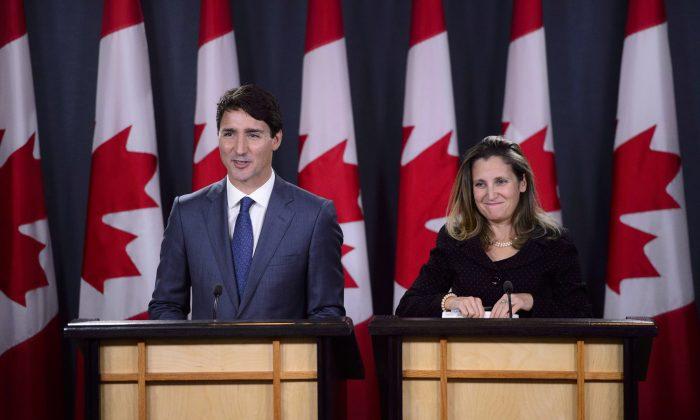Canada’s new trade agreement with the United States and Mexico—the USMCA, which replaces NAFTA—is not just a good deal because of the removal of uncertainty for Canadian business. It also strengthens trade ties with the United States, potentially at China’s expense.
“I think it’s fairly obvious why the U.S. sought those provisions,” said Mark Agnew, director of international policy at the Canadian Chamber of Commerce, in an interview. “The inclusion of it signals the U.S. world view about trade with China.”
For the United States, the real target is China. The world’s two largest economies are involved in rising trade tensions. The United States intends to assert its trade authority in North America while taking China to task for its theft of intellectual property and other international trade violations. At the same time, China also seeks to build its influence around the world.
“I happen to think that anything that makes Canada think more carefully and more deeply about its relationship with China is all to the good.”
Article 32.10 essentially says that notification needs to be provided before negotiation with a “non-market” country, like China, and ultimately gives a partner the ability to withdraw from the USMCA after reviewing the text of a trade deal reached.
“It’s a bit more symbolic rather than having a lot of bite to it,” Agnew said about the text in question.
Both Agnew and Crowley point out that no new ability to withdraw from the USMCA has been created as a result of this article.

“If the U.S. woke up tomorrow and said we’re going to withdraw from the agreement because it’s Wednesday, sure they can do that too,” Agnew said.
Crowley said the article is hardly “astonishing,” nor is it some kind of limitation on Canada’s sovereignty. To his knowledge, it wasn’t a big issue for Canada during the negotiations, although other commentators are now “making a bit of a tempest in a teapot” about it.
“I think people who are making a case that Canada sold out are completely missing the point,” he said.
Uncertainty No More
Trade uncertainty had been the number one threat for the Canadian economy. With the avoidance of tariffs on autos, the worst has certainly been avoided.The biggest areas in which the economy should benefit are in business investment and exports, two components that the Bank of Canada had been haircutting while trade uncertainty persisted.
Now, businesses have 16 years of certainty ahead instead of the original five-year sunset proposal from the United States.
But business investment may be slow to move notably higher, according to Agnew.
Even with the past uncertainty surrounding trade, Canadian firms had already been upbeat about their prospects, according to the Bank of Canada’s business outlook survey from the summer.
Agnew said the removal of uncertainty is one factor that will spur business investment, but the Chamber of Commerce has been decrying Canada’s lack of a competitive business environment with regard to regulation and tax policy.
“I don’t think by any means we should get complacent thinking we have NAFTA [USMCA] delivered so suddenly now business investment won’t be a problem and we don’t have to worry about it anymore,” Agnew said.
Aside from the interests of certain sectors, most notably dairy farmers, the USMCA is beneficial for Canada’s economy, investment, and jobs, in the view of Agnew and Crowley.
“Anything that reduces the power of the supply-managed agriculture cartels in dairy, poultry, eggs—I think that’s in the interest of consumers in Canada,” Crowley said.
Another area that some feel was a concession Canada made is intellectual property (IP), where the USMCA brings in tougher enforcement mechanisms and longer terms for copyrights.
“But in fact, these new IP measures will go a long way toward promoting innovation and protecting the economic activity associated with IP rights in Canada. Much of the IP chapter is a welcome modernization of a dated NAFTA agreement,” said the MLI in a press release.
Agnew points to labour mobility provisions not being rolled back and provisions on digital trade and data localization as being benefits of the modernized USMCA.
Higher Rates
Financial markets expectations for a 0.25 percent rate hike on Oct. 24, the BoC’s next rate decision, are virtually certain. This is up from a 90 percent chance on Sept. 28, according to Andrew Kelvin of TD Securities.He also notes that expectations for the current Bank of Canada 1.50 percent overnight rate target have moved slightly higher for the end of 2019, from 2.25 percent to 2.35 percent post the USMCA announcement.
BMO is already forecasting an additional rate hike in 2019 for a total of three, or 0.75 percent; however, RBC is more sanguine in not changing its base-case economic outlook.
The Canadian dollar surged to a four-month high of $US.078 on Oct. 1 when the trade deal was officially announced.






Friends Read Free